TOYOTA BZ4X 2022 Owners Manual (in English)
Manufacturer: TOYOTA, Model Year: 2022, Model line: BZ4X, Model: TOYOTA BZ4X 2022Pages: 674, PDF Size: 120.02 MB
Page 471 of 674
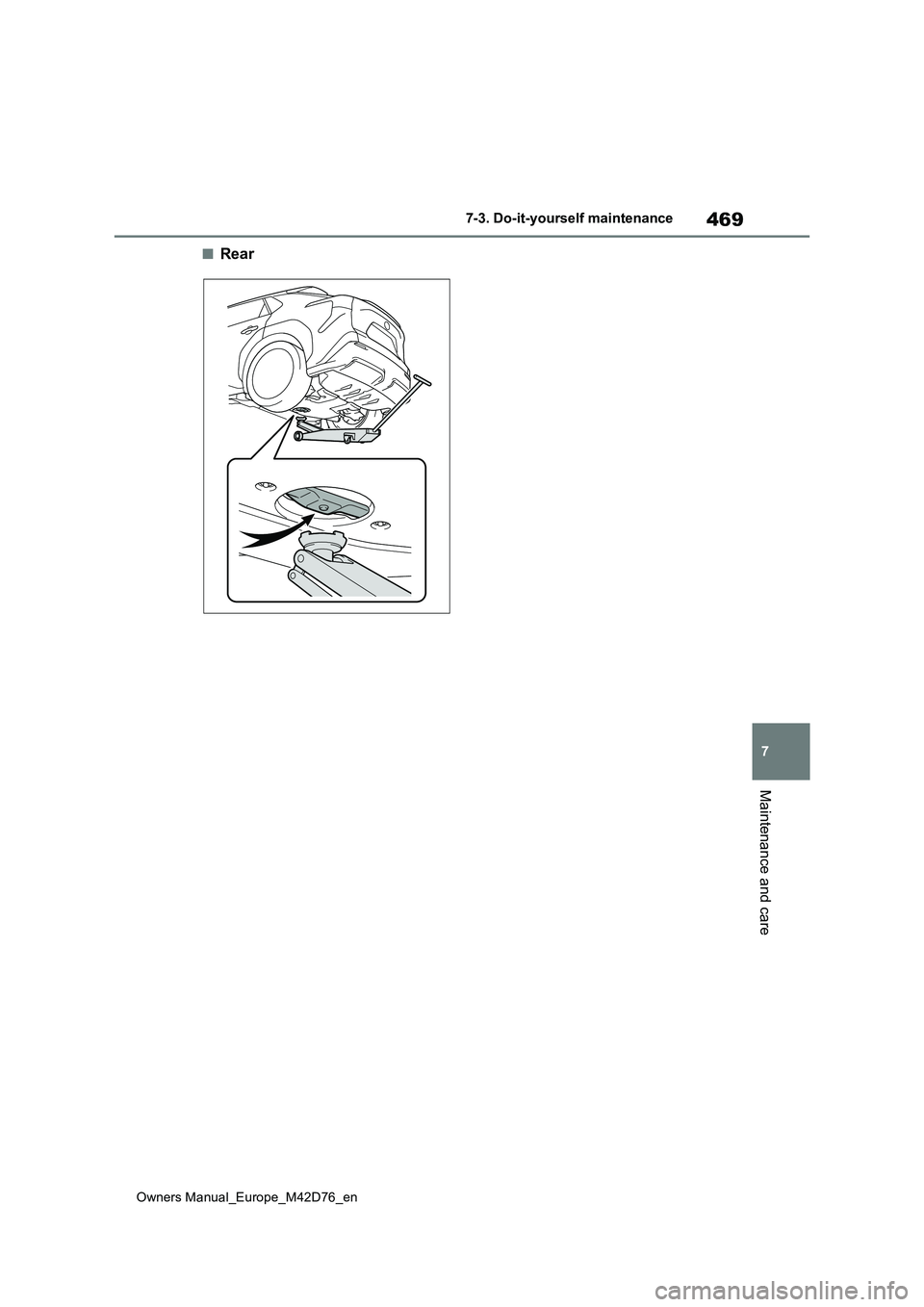
469
7
Owners Manual_Europe_M42D76_en
7-3. Do-it-yourself maintenance
Maintenance and care
■Rear
Page 472 of 674
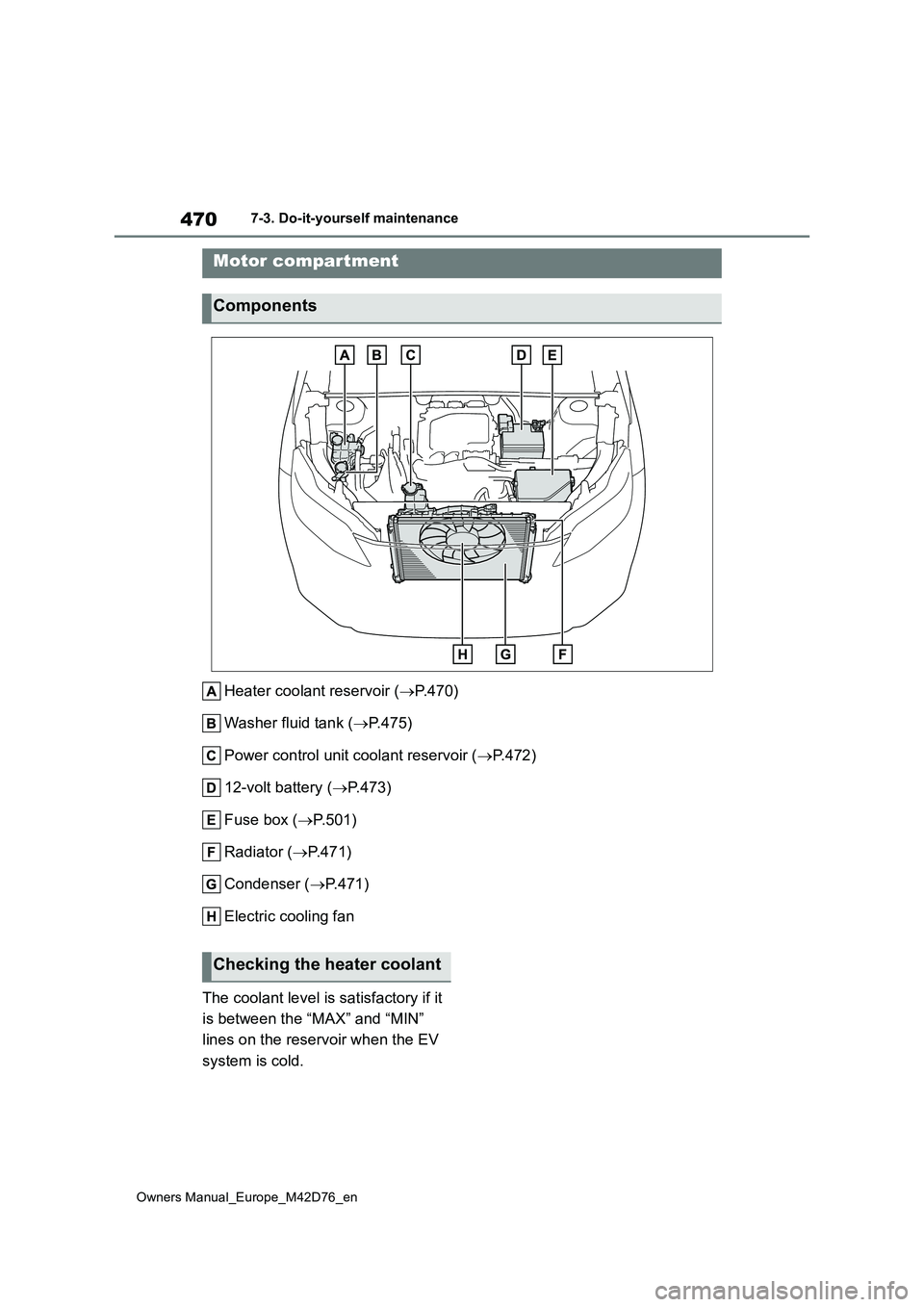
470
Owners Manual_Europe_M42D76_en
7-3. Do-it-yourself maintenance
Heater coolant reservoir (P.470)
Washer fluid tank ( P.475)
Power control unit coolant reservoir ( P.472)
12-volt battery ( P.473)
Fuse box ( P.501)
Radiator ( P.471)
Condenser ( P.471)
Electric cooling fan
The coolant level is satisfactory if it
is between the “MAX” and “MIN”
lines on the reservoir when the EV
system is cold.
Motor compartment
Components
Checking the heater coolant
Page 473 of 674
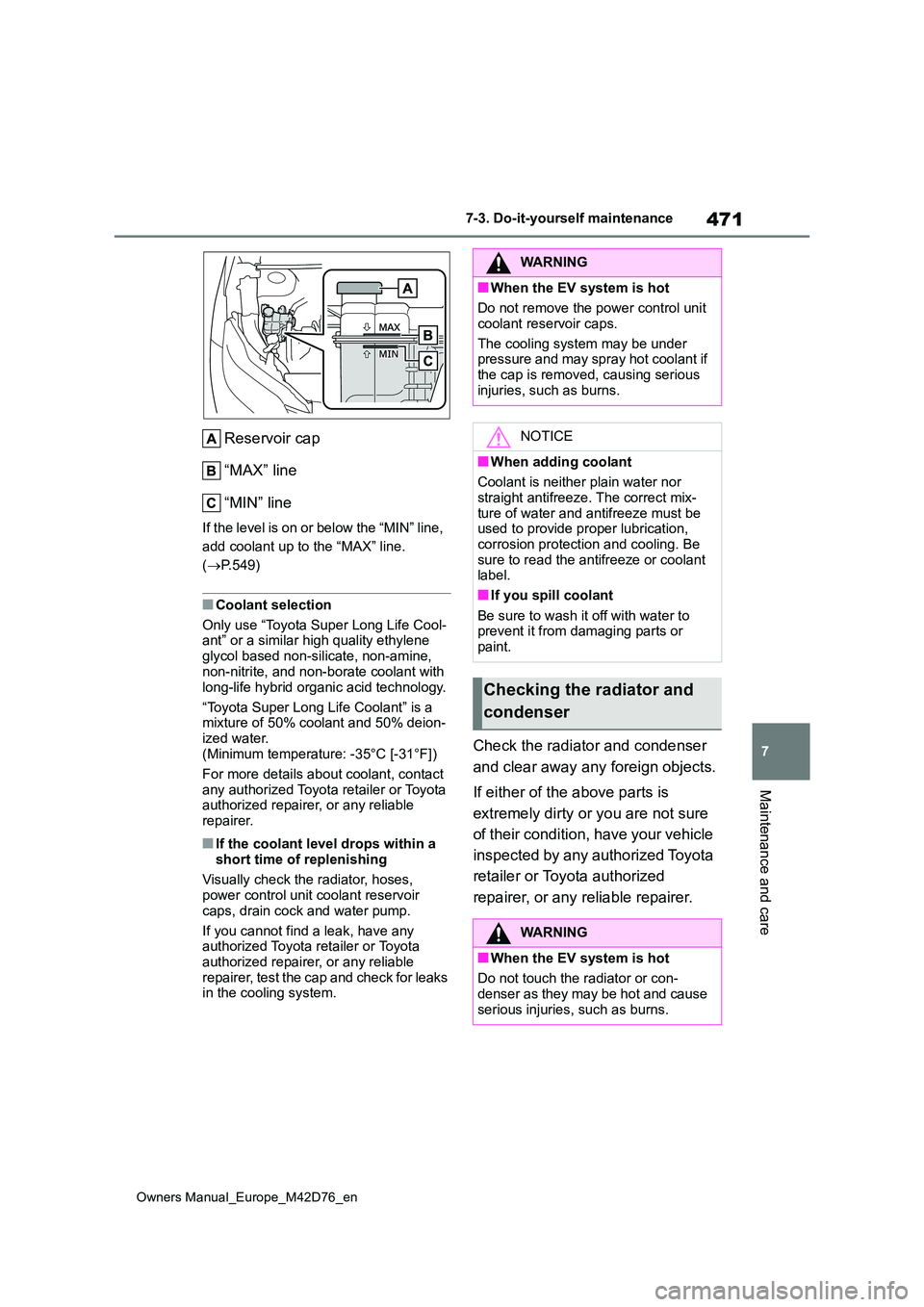
471
7
Owners Manual_Europe_M42D76_en
7-3. Do-it-yourself maintenance
Maintenance and care
Reservoir cap
“MAX” line
“MIN” line
If the level is on or below the “MIN” line,
add coolant up to the “MAX” line.
( P.549)
■Coolant selection
Only use “Toyota Super Long Life Cool- ant” or a similar high quality ethylene
glycol based non-silicate, non-amine, non-nitrite, and non-borate coolant with
long-life hybrid organic acid technology.
“Toyota Super Long Life Coolant” is a mixture of 50% coolant and 50% deion-
ized water. (Minimum temperature: -35°C [-31°F])
For more details about coolant, contact
any authorized Toyota retailer or Toyota authorized repairer, or any reliable repairer.
■If the coolant level drops within a
short time of replenishing
Visually check the radiator, hoses, power control unit coolant reservoir
caps, drain cock and water pump.
If you cannot find a leak, have any authorized Toyota retailer or Toyota
authorized repairer, or any reliable repairer, test the cap and check for leaks in the cooling system.
Check the radiator and condenser
and clear away any foreign objects.
If either of the above parts is
extremely dirty or you are not sure
of their condition, have your vehicle
inspected by any authorized Toyota
retailer or Toyota authorized
repairer, or any reliable repairer.
WARNING
■When the EV system is hot
Do not remove the power control unit
coolant reservoir caps.
The cooling system may be under pressure and may spray hot coolant if
the cap is removed, causing serious injuries, such as burns.
NOTICE
■When adding coolant
Coolant is neither plain water nor straight antifreeze. The correct mix-
ture of water and antifreeze must be used to provide proper lubrication, corrosion protection and cooling. Be
sure to read the antifreeze or coolant label.
■If you spill coolant
Be sure to wash it off with water to prevent it from damaging parts or paint.
Checking the radiator and
condenser
WARNING
■When the EV system is hot
Do not touch the radiator or con-
denser as they may be hot and cause serious injuries, such as burns.
Page 474 of 674
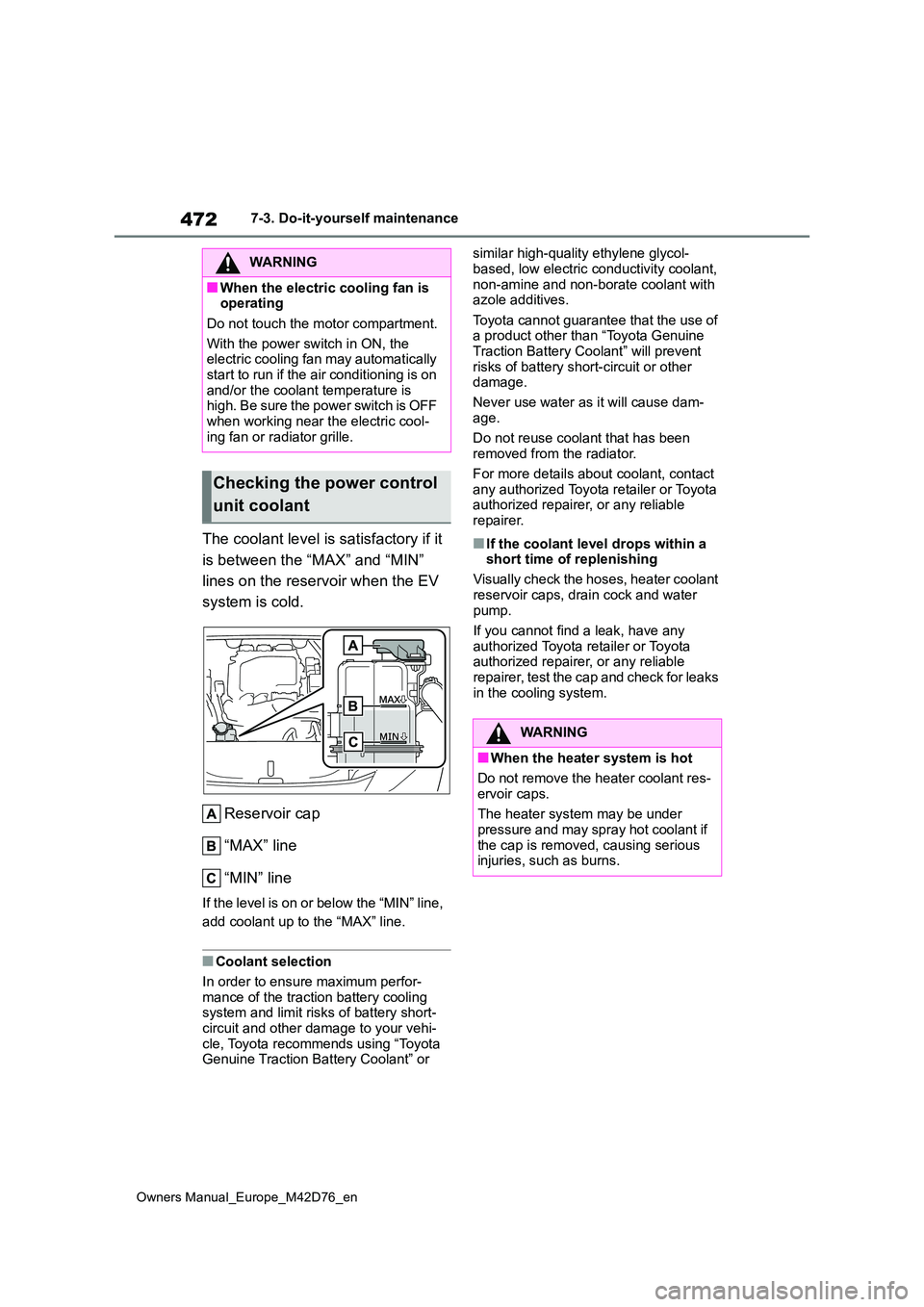
472
Owners Manual_Europe_M42D76_en
7-3. Do-it-yourself maintenance
The coolant level is satisfactory if it
is between the “MAX” and “MIN”
lines on the reservoir when the EV
system is cold.
Reservoir cap
“MAX” line
“MIN” line
If the level is on or below the “MIN” line,
add coolant up to the “MAX” line.
■Coolant selection
In order to ensure maximum perfor-
mance of the traction battery cooling system and limit risks of battery short-circuit and other damage to your vehi-
cle, Toyota recommends using “Toyota Genuine Traction Battery Coolant” or
similar high-quality ethylene glycol-
based, low electric conductivity coolant, non-amine and non-borate coolant with azole additives.
Toyota cannot guarantee that the use of a product other than “Toyota Genuine Traction Battery Coolant” will prevent
risks of battery short-circuit or other damage.
Never use water as it will cause dam-
age.
Do not reuse coolant that has been removed from the radiator.
For more details about coolant, contact any authorized Toyota retailer or Toyota authorized repairer, or any reliable
repairer.
■If the coolant level drops within a short time of replenishing
Visually check the hoses, heater coolant
reservoir caps, drain cock and water pump.
If you cannot find a leak, have any
authorized Toyota retailer or Toyota authorized repairer, or any reliable repairer, test the cap and check for leaks
in the cooling system.
WARNING
■When the electric cooling fan is operating
Do not touch the motor compartment.
With the power switch in ON, the electric cooling fan may automatically
start to run if the air conditioning is on and/or the coolant temperature is high. Be sure the power switch is OFF
when working near the electric cool- ing fan or radiator grille.
Checking the power control
unit coolant
WARNING
■When the heater system is hot
Do not remove the heater coolant res-
ervoir caps.
The heater system may be under pressure and may spray hot coolant if
the cap is removed, causing serious injuries, such as burns.
Page 475 of 674
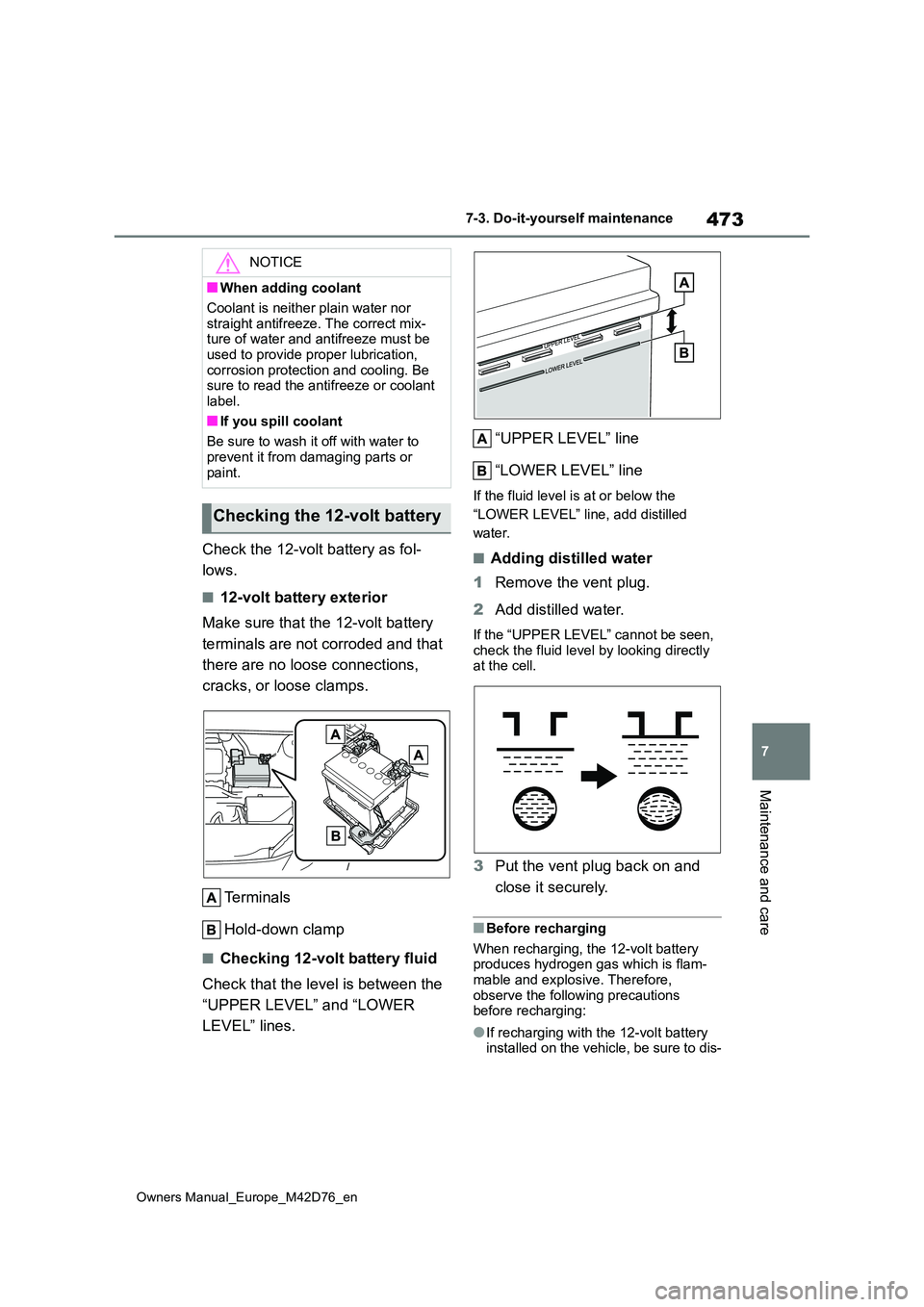
473
7
Owners Manual_Europe_M42D76_en
7-3. Do-it-yourself maintenance
Maintenance and care
Check the 12-volt battery as fol-
lows.
■12-volt battery exterior
Make sure that the 12-volt battery
terminals are not corroded and that
there are no loose connections,
cracks, or loose clamps.
Terminals
Hold-down clamp
■Checking 12-volt battery fluid
Check that the level is between the
“UPPER LEVEL” and “LOWER
LEVEL” lines.
“UPPER LEVEL” line
“LOWER LEVEL” line
If the fluid level is at or below the
“LOWER LEVEL” line, add distilled
water.
■Adding distilled water
1 Remove the vent plug.
2 Add distilled water.
If the “UPPER LEVEL” cannot be seen,
check the fluid level by looking directly at the cell.
3 Put the vent plug back on and
close it securely.
■Before recharging
When recharging, the 12-volt battery produces hydrogen gas which is flam-mable and explosive. Therefore,
observe the following precautions before recharging:
●If recharging with the 12-volt battery installed on the vehicle, be sure to dis-
NOTICE
■When adding coolant
Coolant is neither plain water nor
straight antifreeze. The correct mix- ture of water and antifreeze must be used to provide proper lubrication,
corrosion protection and cooling. Be sure to read the antifreeze or coolant label.
■If you spill coolant
Be sure to wash it off with water to prevent it from damaging parts or
paint.
Checking the 12-volt battery
Page 476 of 674
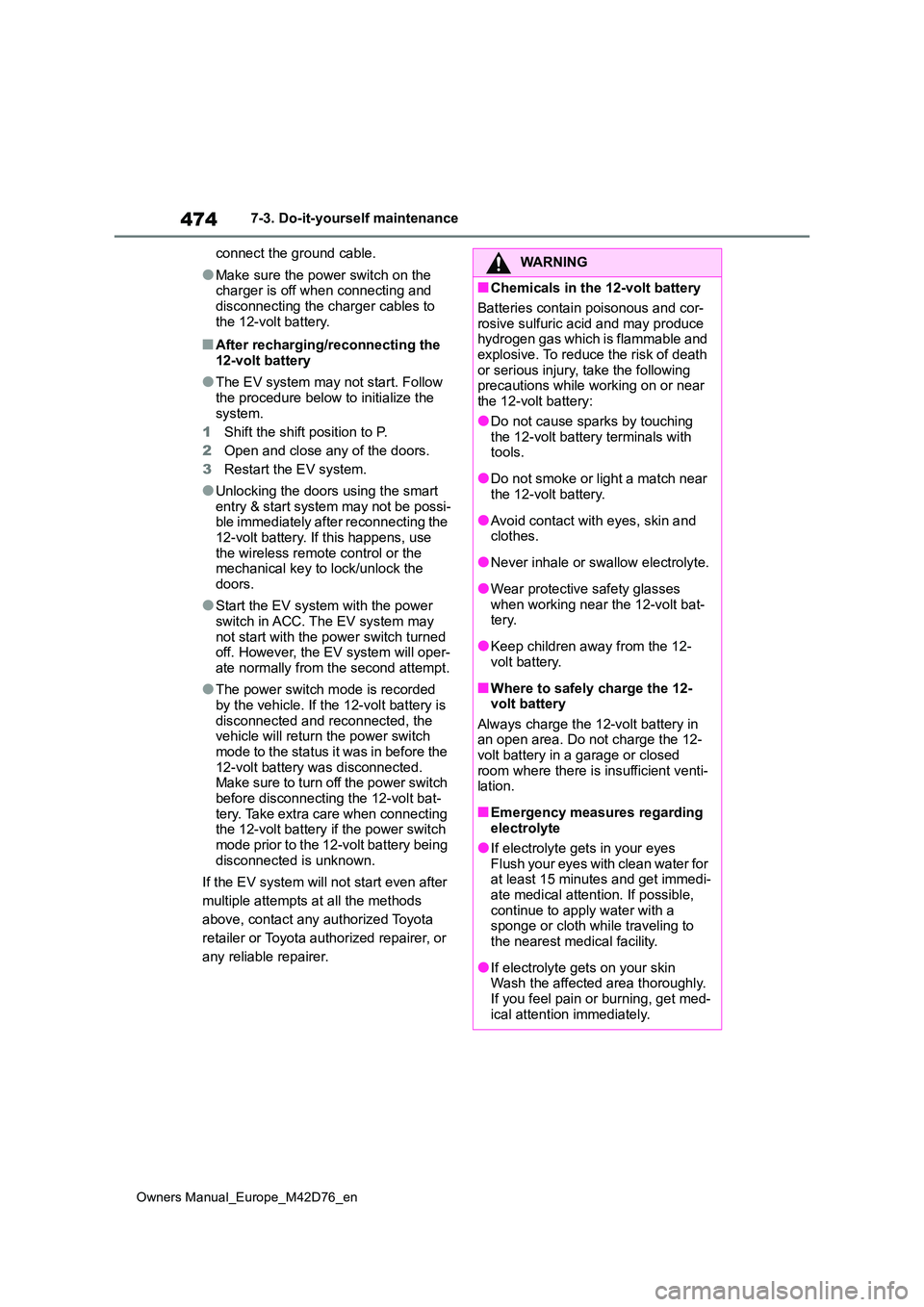
474
Owners Manual_Europe_M42D76_en
7-3. Do-it-yourself maintenance
connect the ground cable.
●Make sure the power switch on the charger is off when connecting and
disconnecting the charger cables to the 12-volt battery.
■After recharging/reconnecting the 12-volt battery
●The EV system may not start. Follow the procedure below to initialize the
system.
1 Shift the shift position to P.
2 Open and close any of the doors.
3 Restart the EV system.
●Unlocking the doors using the smart
entry & start system may not be possi- ble immediately after reconnecting the 12-volt battery. If this happens, use
the wireless remote control or the mechanical key to lock/unlock the doors.
●Start the EV system with the power switch in ACC. The EV system may
not start with the power switch turned off. However, the EV system will oper-ate normally from the second attempt.
●The power switch mode is recorded by the vehicle. If the 12-volt battery is
disconnected and reconnected, the vehicle will return the power switch mode to the status it was in before the
12-volt battery was disconnected. Make sure to turn off the power switch before disconnecting the 12-volt bat-
tery. Take extra care when connecting the 12-volt battery if the power switch mode prior to the 12-volt battery being
disconnected is unknown.
If the EV system will not start even after
multiple attempts at all the methods
above, contact any authorized Toyota
retailer or Toyota authorized repairer, or
any reliable repairer.
WARNING
■Chemicals in the 12-volt battery
Batteries contain poisonous and cor-
rosive sulfuric acid and may produce hydrogen gas which is flammable and explosive. To reduce the risk of death
or serious injury, take the following precautions while working on or near the 12-volt battery:
●Do not cause sparks by touching the 12-volt battery terminals with tools.
●Do not smoke or light a match near the 12-volt battery.
●Avoid contact with eyes, skin and clothes.
●Never inhale or swallow electrolyte.
●Wear protective safety glasses when working near the 12-volt bat-tery.
●Keep children away from the 12-volt battery.
■Where to safely charge the 12-volt battery
Always charge the 12-volt battery in an open area. Do not charge the 12-volt battery in a garage or closed
room where there is insufficient venti- lation.
■Emergency measures regarding electrolyte
●If electrolyte gets in your eyes
Flush your eyes with clean water for at least 15 minutes and get immedi-ate medical attention. If possible,
continue to apply water with a sponge or cloth while traveling to the nearest medical facility.
●If electrolyte gets on your skinWash the affected area thoroughly.
If you feel pain or burning, get med- ical attention immediately.
Page 477 of 674
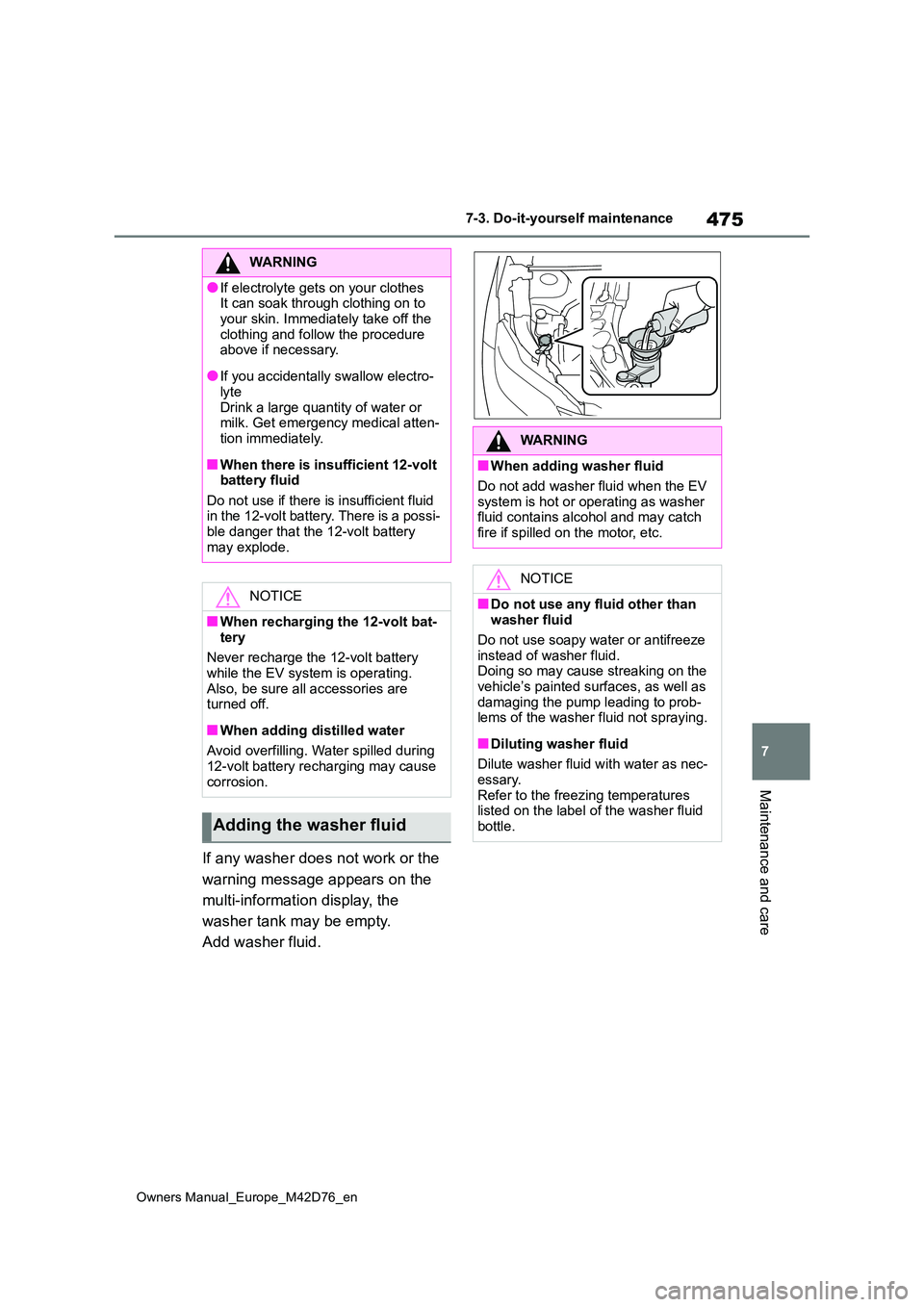
475
7
Owners Manual_Europe_M42D76_en
7-3. Do-it-yourself maintenance
Maintenance and care
If any washer does not work or the
warning message appears on the
multi-information display, the
washer tank may be empty.
Add washer fluid.
WARNING
●If electrolyte gets on your clothes It can soak through clothing on to
your skin. Immediately take off the clothing and follow the procedure above if necessary.
●If you accidentally swallow electro-lyte
Drink a large quantity of water or milk. Get emergency medical atten-tion immediately.
■When there is insufficient 12-volt battery fluid
Do not use if there is insufficient fluid in the 12-volt battery. There is a possi-ble danger that the 12-volt battery
may explode.
NOTICE
■When recharging the 12-volt bat- tery
Never recharge the 12-volt battery while the EV system is operating.
Also, be sure all accessories are turned off.
■When adding distilled water
Avoid overfilling. Water spilled during 12-volt battery recharging may cause
corrosion.
Adding the washer fluid
WARNING
■When adding washer fluid
Do not add washer fluid when the EV
system is hot or operating as washer fluid contains alcohol and may catch fire if spilled on the motor, etc.
NOTICE
■Do not use any fluid other than washer fluid
Do not use soapy water or antifreeze instead of washer fluid.Doing so may cause streaking on the
vehicle’s painted surfaces, as well as damaging the pump leading to prob-lems of the washer fluid not spraying.
■Diluting washer fluid
Dilute washer fluid with water as nec-
essary. Refer to the freezing temperatures listed on the label of the washer fluid
bottle.
Page 478 of 674
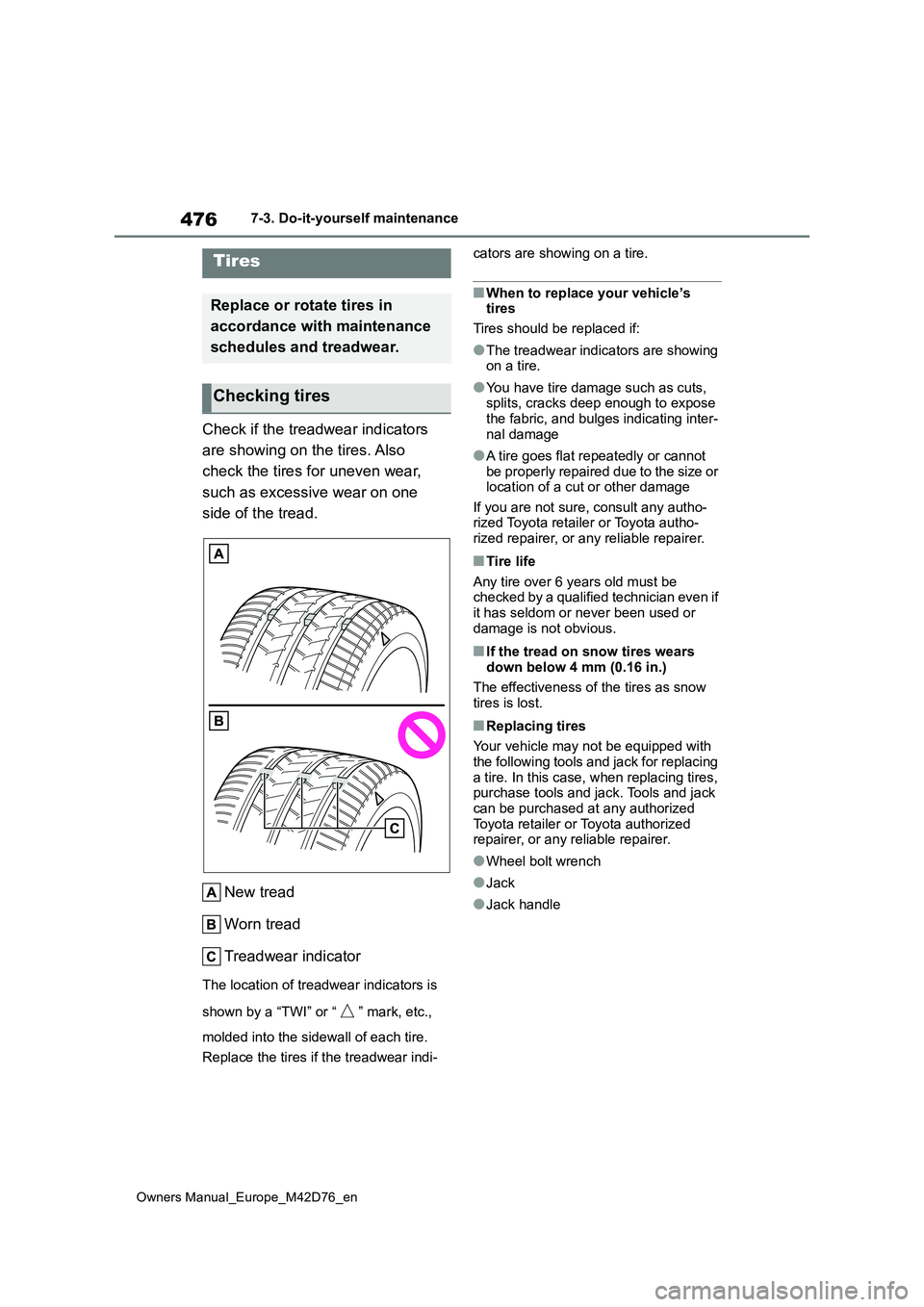
476
Owners Manual_Europe_M42D76_en
7-3. Do-it-yourself maintenance
Check if the treadwear indicators
are showing on the tires. Also
check the tires for uneven wear,
such as excessive wear on one
side of the tread.
New tread
Worn tread
Treadwear indicator
The location of treadwear indicators is
shown by a “TWI” or “ ” mark, etc.,
molded into the sidewall of each tire.
Replace the tires if the treadwear indi-
cators are showing on a tire.
■When to replace your vehicle’s tires
Tires should be replaced if:
●The treadwear indicators are showing on a tire.
●You have tire damage such as cuts, splits, cracks deep enough to expose
the fabric, and bulges indicating inter- nal damage
●A tire goes flat repeatedly or cannot be properly repaired due to the size or location of a cut or other damage
If you are not sure, consult any autho- rized Toyota retailer or Toyota autho-rized repairer, or any reliable repairer.
■Tire life
Any tire over 6 years old must be checked by a qualified technician even if it has seldom or never been used or
damage is not obvious.
■If the tread on snow tires wears down below 4 mm (0.16 in.)
The effectiveness of the tires as snow
tires is lost.
■Replacing tires
Your vehicle may not be equipped with the following tools and jack for replacing
a tire. In this case, when replacing tires, purchase tools and jack. Tools and jack
can be purchased at any authorized Toyota retailer or Toyota authorized repairer, or any reliable repairer.
●Wheel bolt wrench
●Jack
●Jack handle
Tires
Replace or rotate tires in
accordance with maintenance
schedules and treadwear.
Checking tires
Page 479 of 674
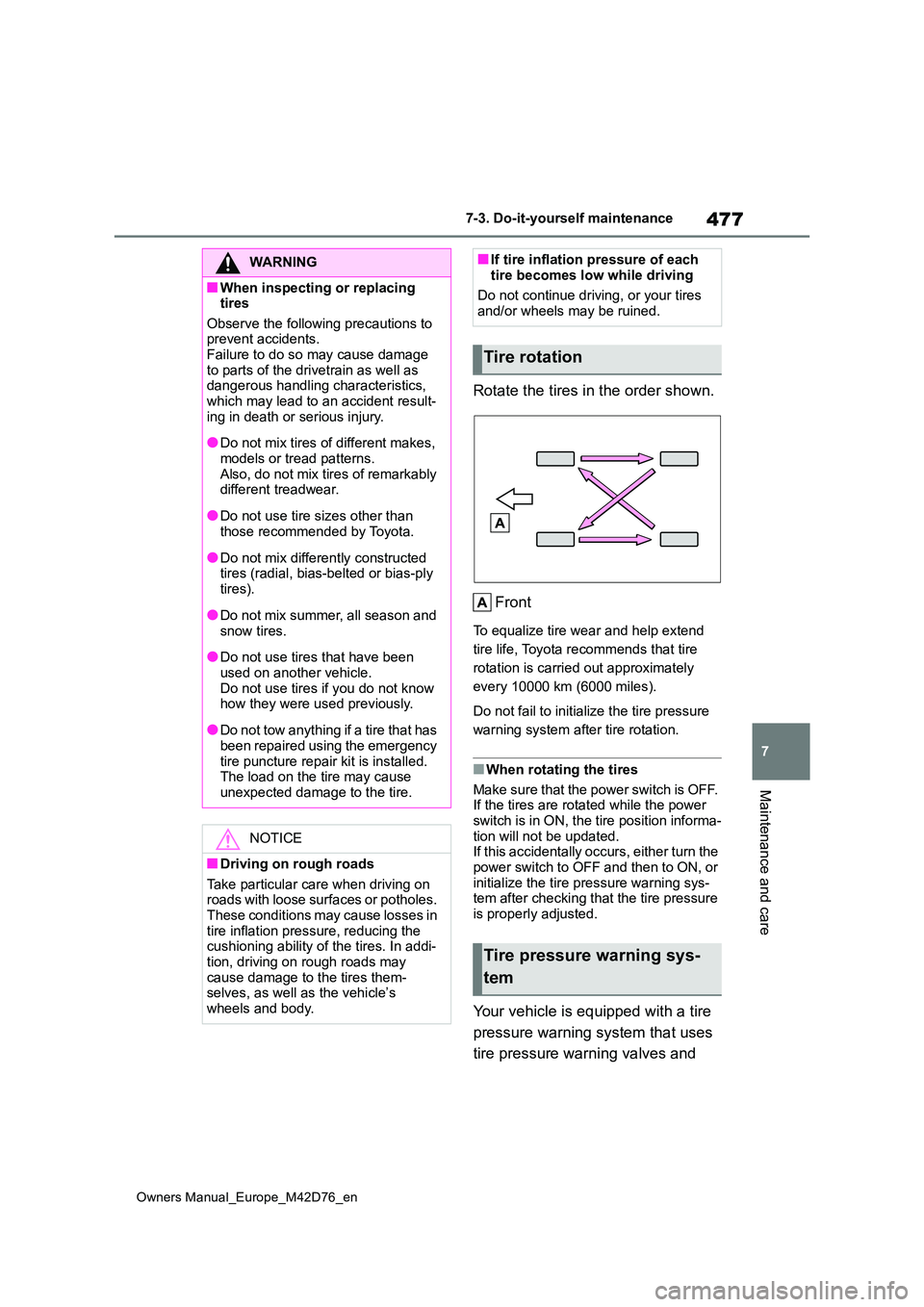
477
7
Owners Manual_Europe_M42D76_en
7-3. Do-it-yourself maintenance
Maintenance and care
Rotate the tires in the order shown.
Front
To equalize tire wear and help extend
tire life, Toyota recommends that tire
rotation is carried out approximately
every 10000 km (6000 miles).
Do not fail to initialize the tire pressure
warning system after tire rotation.
■When rotating the tires
Make sure that the power switch is OFF. If the tires are rotated while the power
switch is in ON, the tire position informa- tion will not be updated. If this accidentally occurs, either turn the
power switch to OFF and then to ON, or initialize the tire pressure warning sys-tem after checking that the tire pressure
is properly adjusted.
Your vehicle is equipped with a tire
pressure warning system that uses
tire pressure warning valves and
WARNING
■When inspecting or replacing tires
Observe the following precautions to prevent accidents. Failure to do so may cause damage
to parts of the drivetrain as well as dangerous handling characteristics, which may lead to an accident result-
ing in death or serious injury.
●Do not mix tires of different makes,
models or tread patterns. Also, do not mix tires of remarkably different treadwear.
●Do not use tire sizes other than those recommended by Toyota.
●Do not mix differently constructed tires (radial, bias-belted or bias-ply
tires).
●Do not mix summer, all season and
snow tires.
●Do not use tires that have been
used on another vehicle. Do not use tires if you do not know how they were used previously.
●Do not tow anything if a tire that has been repaired using the emergency
tire puncture repair kit is installed. The load on the tire may cause unexpected damage to the tire.
NOTICE
■Driving on rough roads
Take particular care when driving on roads with loose surfaces or potholes. These conditions may cause losses in
tire inflation pressure, reducing the cushioning ability of the tires. In addi-tion, driving on rough roads may
cause damage to the tires them- selves, as well as the vehicle’s wheels and body.
■If tire inflation pressure of each tire becomes low while driving
Do not continue driving, or your tires
and/or wheels may be ruined.
Tire rotation
Tire pressure warning sys-
tem
Page 480 of 674
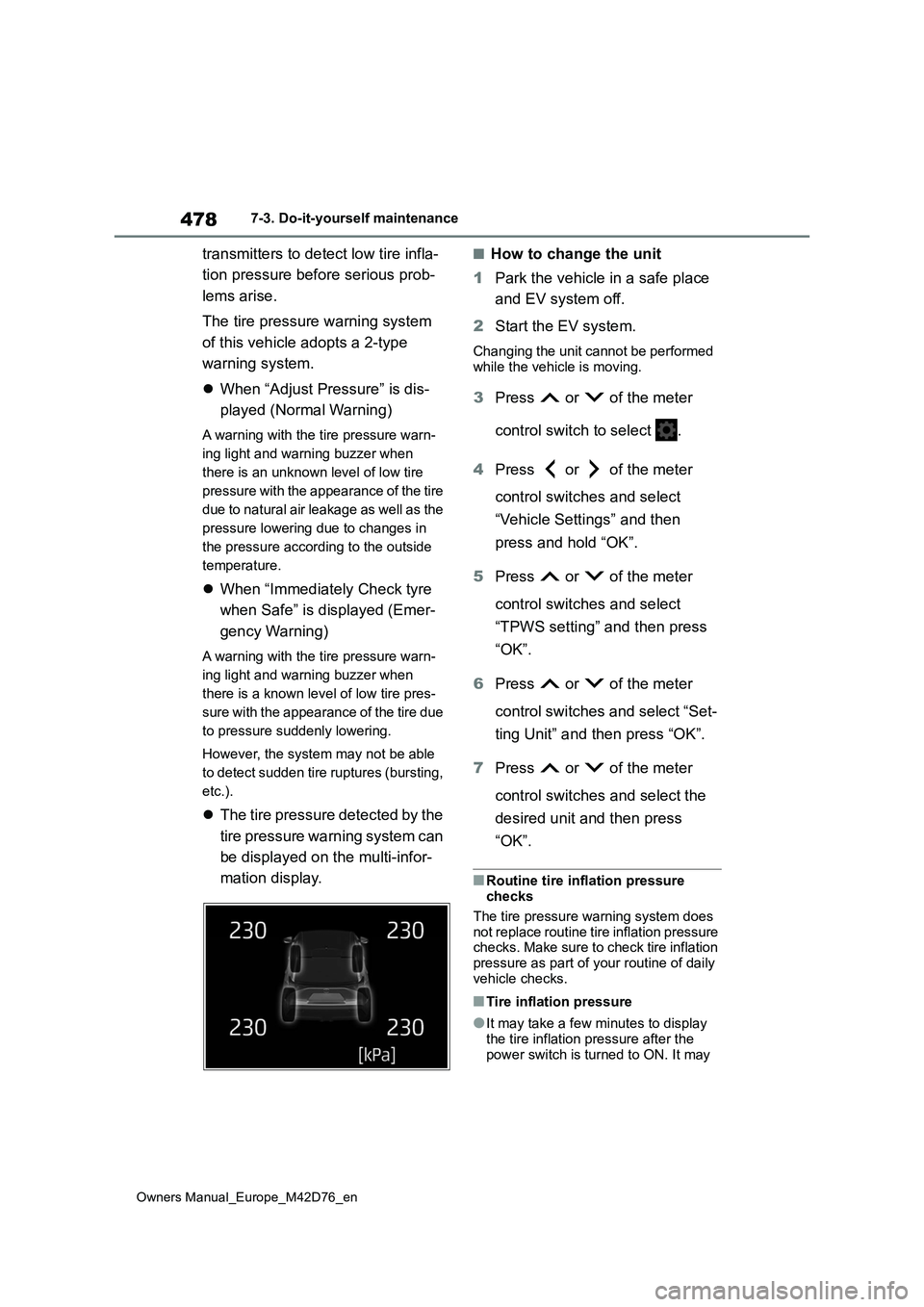
478
Owners Manual_Europe_M42D76_en
7-3. Do-it-yourself maintenance
transmitters to detect low tire infla-
tion pressure before serious prob-
lems arise.
The tire pressure warning system
of this vehicle adopts a 2-type
warning system.
When “Adjust Pressure” is dis-
played (Normal Warning)
A warning with the tire pressure warn-
ing light and warning buzzer when
there is an unknown level of low tire
pressure with the appearance of the tire
due to natural air leakage as well as the
pressure lowering due to changes in
the pressure according to the outside
temperature.
When “Immediately Check tyre
when Safe” is displayed (Emer-
gency Warning)
A warning with the tire pressure warn-
ing light and warning buzzer when
there is a known level of low tire pres-
sure with the appearance of the tire due
to pressure suddenly lowering.
However, the system may not be able
to detect sudden tire ruptures (bursting,
etc.).
The tire pressure detected by the
tire pressure warning system can
be displayed on the multi-infor-
mation display.
■How to change the unit
1 Park the vehicle in a safe place
and EV system off.
2 Start the EV system.
Changing the unit cannot be performed
while the vehicle is moving.
3 Press or of the meter
control switch to select .
4 Press or of the meter
control switches and select
“Vehicle Settings” and then
press and hold “OK”.
5 Press or of the meter
control switches and select
“TPWS setting” and then press
“OK”.
6 Press or of the meter
control switches and select “Set-
ting Unit” and then press “OK”.
7 Press or of the meter
control switches and select the
desired unit and then press
“OK”.
■Routine tire inflation pressure checks
The tire pressure warning system does
not replace routine tire inflation pressure checks. Make sure to check tire inflation pressure as part of your routine of daily
vehicle checks.
■Tire inflation pressure
●It may take a few minutes to display
the tire inflation pressure after the power switch is turned to ON. It may